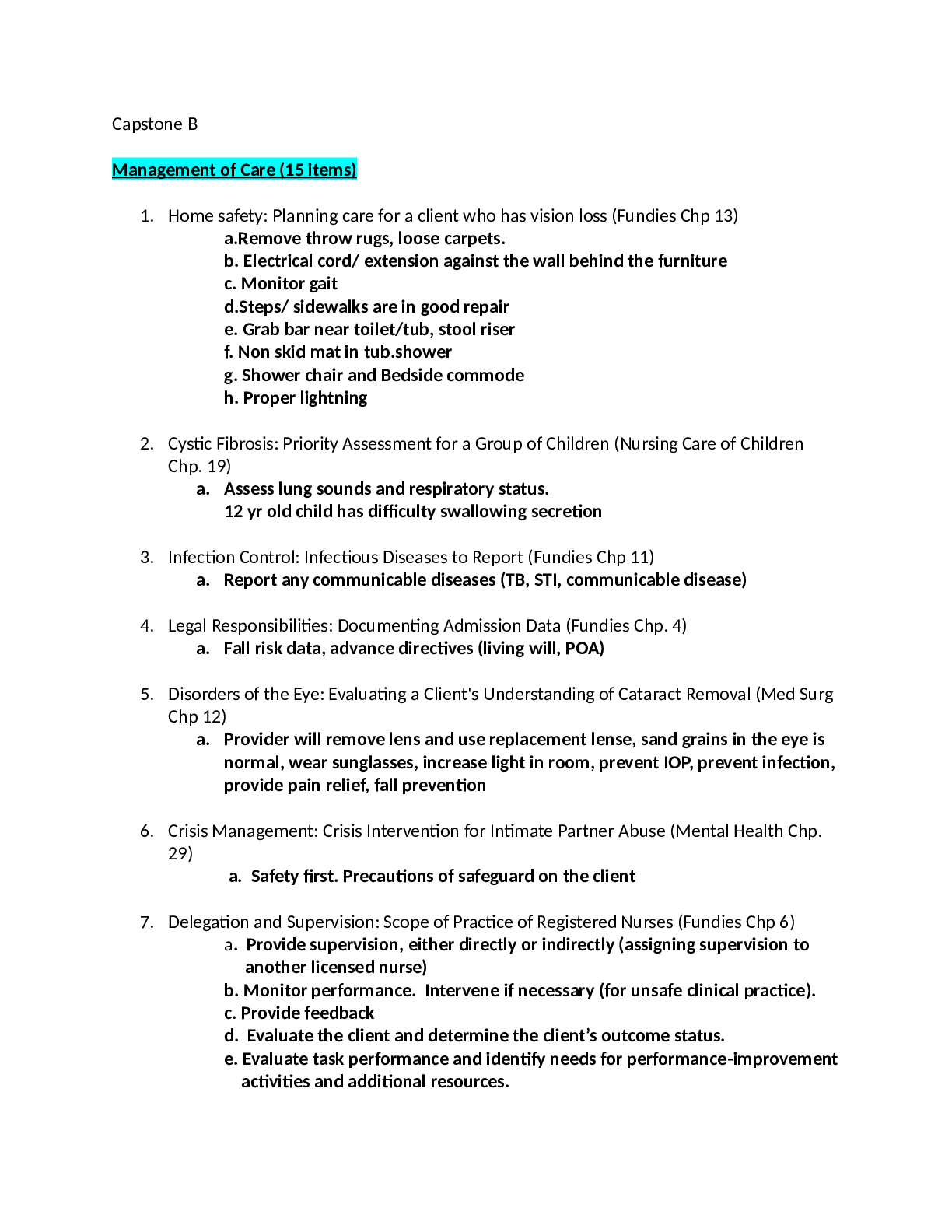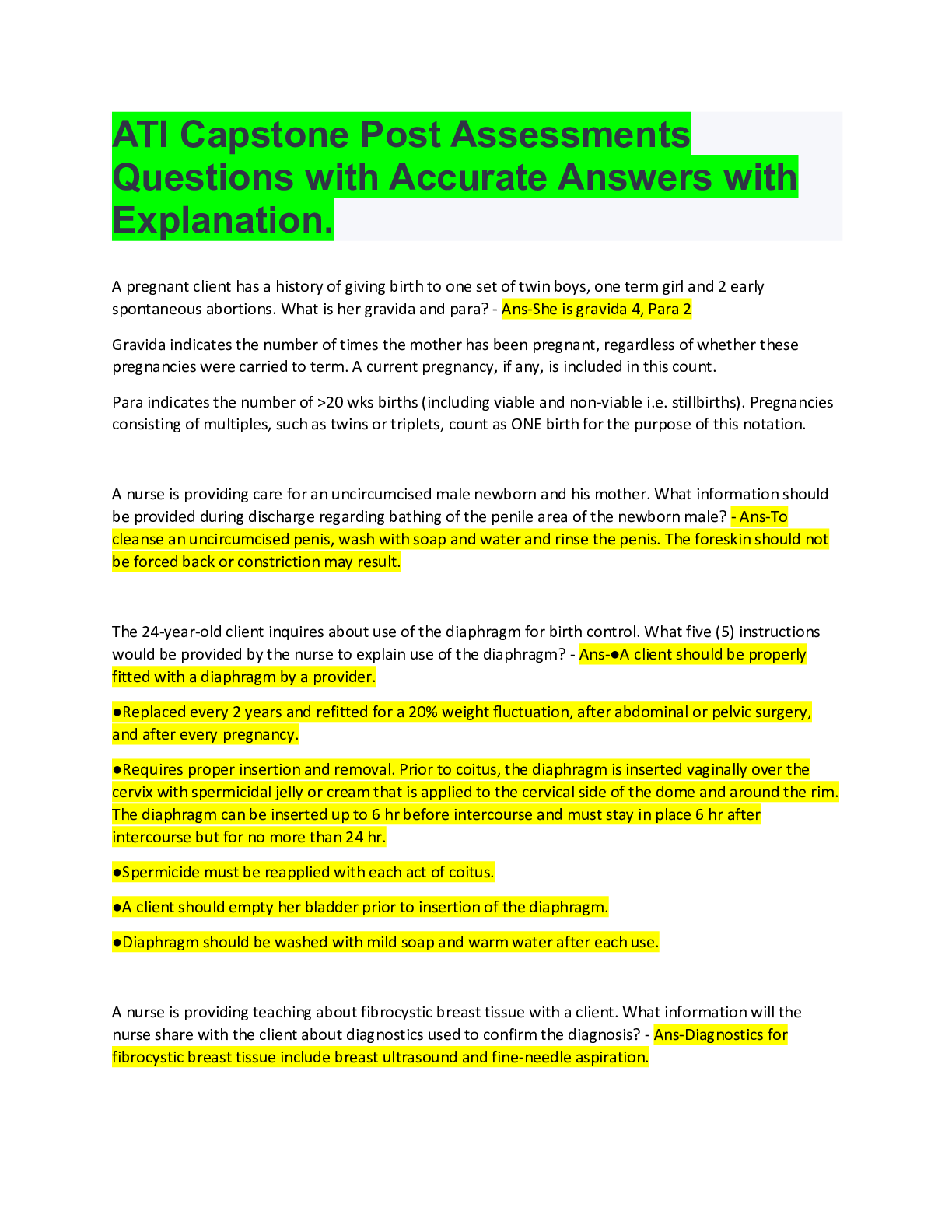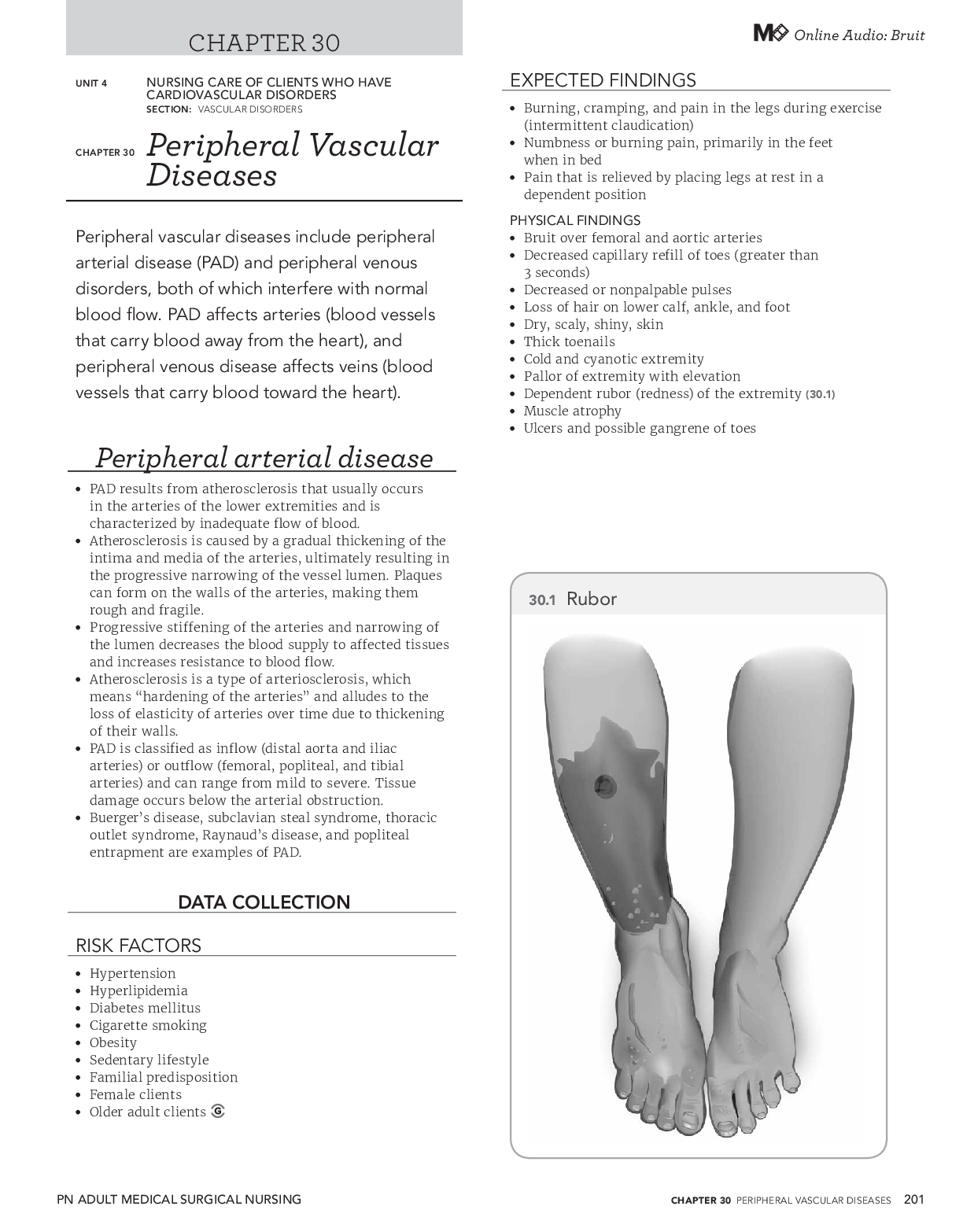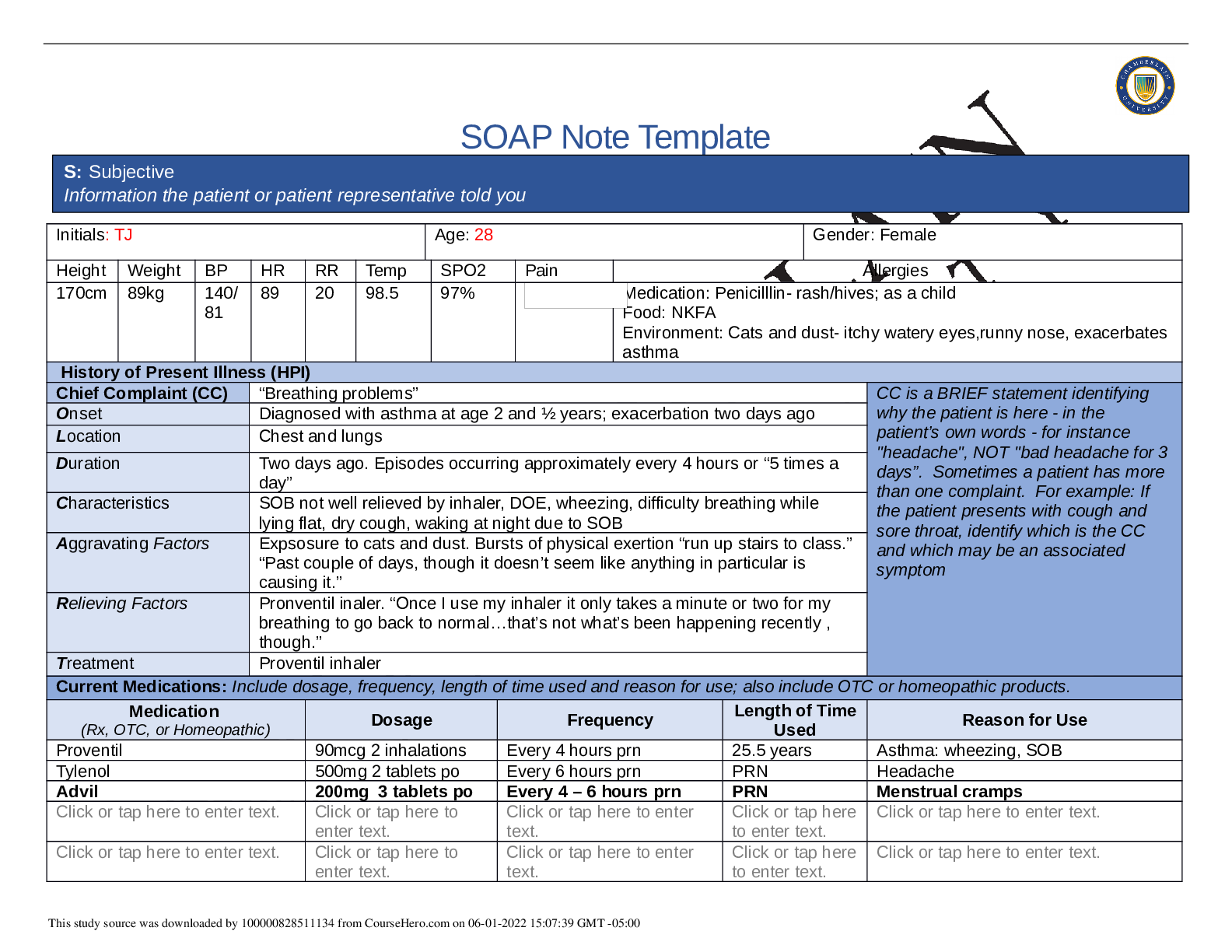*NURSING > CAPSTONE SIMULATION > NR506 APN CAPSTONE PORTFOLIO PART 2 (UPDATED) (All)
NR506 APN CAPSTONE PORTFOLIO PART 2 (UPDATED)
Document Content and Description Below
APN CAPSTONE PORTFOLIO PART 2 1 Capstone Portfolio Part 2 Ashley N. PeacockName NR 661: APN Capstone Practicum Class March 2020DateAPN CAPSTONE PORTFOLIO PART 2 Table of Contents 2 Exemplars 1 - ... 10………..………………………………………………..…..…….#1-55 References…………………………………….……………………………….….#56-64 Appendix A: Concept Map……………………………………………………….…..#65 Appendix B: Table of Exemplars……………………………………………….…….#66APN CAPSTONE PORTFOLIO PART 2 APN Capstone Portfolio Part 2 3 The purpose of this APN Capstone Portfolio is to highlight my professional growth and expertise by providing evidence of the knowledge I have learned. This paper will demonstrate how IWrite an introduction paragraph that introduces the topic of your paper and summarizes the key points that will be discussed. Hint: state that you have met Chamberlain University’s program outcomes (PO), the Essentials of Master’s Education (MSN Essentials), and the National Organization of Nurse Practitioner Faculties (NONPF) Core Competencies. I State that this paper will identify and explain how you have met each of these objectives were met by providing exemplars of myyour graduate work, reflect on how meeting these objectives have transformed meyou into a prospective masters-prepared nurse, and present how the concepts from your work interrelate. Exemplar 1: NR500 Week 3 Addressing Bias PaperWrite the Name of the Piece of Work Copy the exemplar here. Although experiences can shape our development of a bias mindset; it can be challenging to not permit these biases to affect how we interact and care for patients. By analyzing and reaffirming our personal biases during the week 3 paper assignment I was able to be better prepared to be a leader with integrity and self- awareness to provide optimal care to all patients. Self-awareness is a process of objective examination of oneself and is one of the important components in nurse-client relationship. Addressing bias is an important step in creating self-awareness. Although experiences can shape our development of a bias mindset; it can be challenging to not permit these bias thoughts to affect how we interact and care for patients.APN CAPSTONE PORTFOLIO PART 2 TThis attribute reflects the cognitive exploration of own thoughts, feelings, 4 beliefs, values, behaviors, allows one to understand nd how they can affect others (Rasheed, 2015). Therefore, it is critical that if any negative attitudes toward any patient strategies must be developed toand utilize to eliminate them. This paper also allowed me to develop such strategies to use to ensure I am not being bias towards any patient. For example, at the end of each day on the drive home I self-reflect on the care I provided my values, behaviors, feelings, and thoughts of how I would feel if I was the patient so that I could provide better care the following day. This paper also allowed me to reflect on unconscious stereotyping and prejudice contribute to healthcare disparities to advocate for fairness and the elimination of such negative behavior and mindsets. According to Philip, Chadee, and Yearwood (2014), study found that in Trinidad and Tobago discrimination is still present especially against people diagnosed with HIV/AIDS and at-risk groups. This negative attitude therefore creates barriers to accessing important testing and treatment services. Another study sought the view from nurses of what it means to provide care to the obese. Marques, De Melo, and Dos Santos (2014), study also found several bias and negative attitudes toward obese patient that included: being obese is excessive, it is not healthy; Providing care to the obese is a structural issue; Obese patients are troublesome, they require care, no big deal; Providing care to the obese requires teamwork. These negative views can interfere in the care provided and vital to eliminate as advanced practice nurses. This reflective paper also allowed me to understand, value cultural differences, and the importance of cultural competence. As we move to increasingly diverse society; the U.S. Census Bureau projects that the United States will be a majority-minority nationAPN CAPSTONE PORTFOLIO PART 2 5 by 2043, and bBeing cCultural competence is vital. Cultural competencethrough training also encompasses the needed knowledge about diverse people and their needs, attitudes that recognize and value difference, and flexible skills to provide appropriate and sensitive care to diverse populations (Kools, Chimwaza, & Macha, 2015). Organizations that wish to stay relevant in a society with rapidly changing demographics are learning that organizational cultural competence is the first step in reaching and employing diverse audiences. Cultural competence also enables effective teamwork in cross-cultural communities or programs by giving individuals and organizations the framework for operating in varying cultural contexts. Culturally competent organizations are equipped to work with people who have different backgrounds, attitudes, and worldviews thus building a larger, more powerful organization (Mcmullen-Bushman, 2017). constituency Identify and Explain This exemplar shows evidence that I have met program outcome number #3 engage in lifelong personal and professional growth through reflective practice and appreciation of cultural diversity. By completing the week 3 addressing bias paper I was able to not only reflect on and identify bias thoughts that I may hold or that may be seen in practice to effectively strategize to eliminate them to prevent any hinderance in care to any patient. By reflecting daily on my personal values, beliefs, and attitudes that I may hold to develop steps to ensure that I am not being bias to any patient under my carAPN CAPSTONE PORTFOLIO PART 2 6 services. As new graduate advanced practice nurse this is a vital step to be an effective role model, successful career, and business. MSN Essentials III: Quality Improvement and safety was also met through the completing of the reflective paper on addressing bias; I was able to understand the importance of self-awareness, holding bias ideas, and the importance of eliminating such ideas in the healthcare environment through daily self-reflection of my personal interaction with patient and staff members, my values, belief and attitudes. Self-reflection allows the identification of any bias ideas that may hinder care and direct quality improvement methods to promote culturally responsive, safe, timely, effective, efficient, equitable, and patient-centered care therefore meeting this master’s essential (AACN, 2011). NONPF #9 Independent Practice Competencies-develops strategies to prevent one’s own personal biases from interfering with delivery of quality care. Through the completion of week 3 addressing bias paper I was able to self-reflect on my own bias that I may hold and identify biases in the profession environment that could hinder optimal patient- centered care. I was also able to understand the importance cultural competencies, cultural humility, and eliminating bias thoughts in order to promote optimal culturally sensitive patient centered care with partnership of all patients (National Organization of Nurse Practitioner Faculties [NONPF], 2013) Connect The concepts identified in this exemplar are social justice, and cultural humility. Social justice as a concept is defined as a "nursing's professional responsibility to address unjust systems and structures (ANA (2019)." In order to address unjust systems andAPN CAPSTONE PORTFOLIO PART 2 7 structures self-awareness is needed to remove any self-bias ideas against any patient that may hinder care. To be socially justice I must also be culturally competent of other’s culture as this nation is moving towards a more diverse society. To provide optimal care for all cultures I must understand different cultures to promote optimal care and change in systems and structures as needed for all when it is unjust and cultural humility is a life- long commitment to always self-reflect and change cultural bias thoughts (Thurman & Pfitzinger-Lippe, 2017). Cultural humility is more important than working to become competent in the cultures of those with whom we work and interact with. Cultural humility is defined as “a lifelong commitment to self-evaluation and critique, to redressing power imbalances and to developing mutually beneficial and non-paternalistic partnerships with communities on behalf of individuals and defined populations.” Ccultural competence is a reminder to always aim to know more about communities of all types with which we work or interact. Together with the concept and embodied practice of deep cultural humility, it provides myself and other health professionals with important tools in working with diverse individuals, groups, and communities in today’s complex world. cultural humility, for example, through daily reflection helps me to recognize my own biases and stereotypic beliefs to promote change in my heart, care and the health-care environment (Greene- Moton & Minkler, 2020). Reflect Add your reflection on how meeting these objectives have transformed you as a prospective masters-prepared advanced practice nurseThe current healthcare environment is increasing in diversity along with increasing globalization and advancing technologiesAPN CAPSTONE PORTFOLIO PART 2 8 this can produce complex ethical pressures that can influence nursing practice and care outcome. Master's prepared nurses advanced practice nurse (APN) are charged and equipped to take on leadership roles and affect positive change to promote health and health outcomes. In order to be effective in the advanced practice role, it is important to APNs understand their personal values, beliefs, strengths, weaknesses and most importantly unconscious biases he or she may hold as they affect care. A solid foundation of self-knowledge and awareness is needed to make ethical decision that will affect many different aspects of health, healthcare, and outcomes of a variety of people of different cultural backgrounds.. Meeting the above objectives has transformed me as a prospective masters-prepared advanced practice nurse that is not just culturally competent but grounded in cultural humility through daily reflection of the care that I provide. Exemplar 2: NR501-week 7 summary of healthcare concern presentation.Write Name of the Assignment During week seven of the Healthy policy course I competed a project and developed a PowerPoint to present an examination of leadership strategies and contemporary concerns as it relates healthcare policy making in my home area. As a future Family Nurse Practitioner, it is a duty to be advocate for our patient, and to give voice to needed changes in the profession and the community we serve in order to promote a safety and optimize the quality of care. Sometimes to be an advocate expands beyond the bedside and voice is needed at a higher level where health-care decision and policies are created. APRNs have the knowledge and skills to initiate and promote change to policymakers and are obligated (Porche, 2019).APN CAPSTONE PORTFOLIO PART 2 Nursing’s call to political activism and policy advocacy emerges from many 9 different viewpoints. Nursing has a commitment to the public. In the community setting, nurses frequently work with residents and community leaders to advocate for healthier neighborhoods. Working alongside members of the community, community health nurses seek to mitigate the social determinants of illness through advocacy at the individual, system, and policy levels. As experts in the delivery of health care and the promotion of health, nurses are also frequently engaged in issue advocacy, addressing such issues as access to care and disease prevention (Milstead, 2016). Add your exemplar here. As a future FNP one area of concern is the imbalance nutrition among children. Imbalanced intake of fruits and vegetables is of critical importance to the health and development of children. In the United States, imbalanced nutrition plays a part in the increasing percentage of children and adolescents with obesity, which has tripled since the 1970s. From 2015–2016, nationally one in five children and young adults aged 6–19 years were obese. Currently, in Coffee County, Alabama, heart disease is the number one cause of death (The Office of Primary Care and Rural Health, Alabama Department of Public Health, and The Alabama Rural Health Association, 2013), and obesity is the fourth most important health concern for the state (State of Alabama Department of Public Health, 2015). Jan Hendricks is the Director of Nutrition in Coffee County School District and the elected official designee. Unfortunately, I was not able to meet or get in contact with the elected officials I had identified however unknowingly Jan is actually the one who approves any changes or recommendation regarding the menu for students attending Coffee County School System. Wednesday October 17th 2018 @ 0900 am I officiallyAPN CAPSTONE PORTFOLIO PART 2 meet Jan Hendricks at the Board of Education in Elba, AL. I presented a PowerPoint presentation concerning my concern regarding Imbalanced nutrition among children and my proposed solution, the smoothie bar at snack time. After the meeting I learned that Coffee County School System has a farm to 10 school in place that delivers fresh fruits and vegetables to high schoolers. The high school also has a garden that the students created and maintain. Jan felt it would be a great idea to have the student grow and eat their own produce. Jan went on and stated that more manpower will be needed to implement the smoothie bar into place. Some revisions I would make to my solution would be resolution to increasing manpower with the use of the Parent-Teacher Association. I would like to build rapport with the PTA and Jan to strategize in finding a resolution in the best way to train individuals with operating the smoothie bar. I would also like to involve the high schooler from the home economics class to hear their input as it relates to the smoothie operation. By completing this project, I was able to use strategies learned from the course to implement concerns and give voice in my local area for a needed change in policy. Identify and Explain This exemplar has met the PO #1 Provide high quality, safe, patient-centered care grounded in holistic health principles. This exemplar demonstrated how to employ strategies to impact the development, implementation, and consequences of holistic focused healthcare policies using evidence-based practice principles to meet this program outcome. During the project I translated evidence from research to present to an elected official Jan, to highlight why a change was needed to their policy for school age children at risk of imbalance nutrition and how to balance nutrition school age children with theAPN CAPSTONE PORTFOLIO PART 2 11 incorporation of a smoothie bar to increase the consumption of more fruits and vegetables in their diet. Secondly, this exemplar has met the MSN Essential#VI: Health Policy and Advocacy which recognizes that the master’s-prepared nurse is able to intervene at the system level through the policy development process and to employ advocacy strategies to influence health and health care. This exemplar demonstrated how I was able to schedule an appointment and present research evidence to an elect official with decision- making power to promote change in the dietary health of children in coffee county to work toward reducing imbalance nutrition. Lastly, this exemplar met the NONPF Core competency#6: Policy Competencies- contributes in the development of health policy. By developing a research based PowerPoint on the importance of healthy diet among school age children and presenting to an elect official in position to make needed dietary changes in policy was completed in the week Identify your POs, MSN essentials, and core competencies here. Give a brief explanation on how this exemplar shows that you’ve met these objectives. seven summary of healthcare concern presentation I was able to meet this core competency. Connect This exemplar emphasizes the concept of advocacy and health policy. Advocacy for health is defined as an act of safeguarding, apprising, valuing, mediating, and championing social justice in the provision of healthcare. As APRNs we are charged to be advocates for the nursing profession itself by educating and appealing to state and federal legislators and policymakers when a change is needed. APRNs have advanced knowledge and skills to present healthcare concerns to legislation for needed change.APN CAPSTONE PORTFOLIO PART 2 APRNs are on the front lines of health care and treat multiple patients with unique needs and can relate personal experiences regarding how legislation can impact these patients and how a change in policy is beneficial and necessary (Abbasinia, Ahmadi & Kazemnejad, 2020). The term policy refers to decisions or ideologies that act as guidelines for actions. 12 Policy can also refer to suggestions, goals, position declarations, or opinions within organizations. A health policy is therefore a policy that will impact the health of individuals, families, populations, or communities (Porche, 2019). As APRNs we can influence health policy to protect the quality of care. APRNs who advocate for health policies can influence numerous individuals depending on the level of the health policy. APRNs can conduct quality improvement projects in their working environments and can use their findings to help implement new policies as seen in the exemplar. I will be working with patients on a daily basis, I can share their personal stories or research findings about how an enacted bill could have helped specific patient reduce complications, or perhaps may have reduced health costs by screening or treatment at an earlier disease stage (Chilton, 2015). Present and define your con Reflect By meeting the above objectives, it transformed me as APRN equipped to advocate for needed health policy changes and equipped with requisite knowledge and skills to promote health, help shape the health delivery system, and advance values like social justice through policy processes and advocacy. APNs are call to political activism and policy advocacy and have a commitment to the public. The profession's practice is centered in laws, standards, and ethics of activism for social justice. A social contractAPN CAPSTONE PORTFOLIO PART 2 13 with society demands professional responsibility. APNs therefore have a duty to promote change and have an obligation to advance the quality of the health-care delivery. Health policy is an essential component of professional development in nursing. Giving voice to the needs of the profession and providing ideal direction at different policy levels are critical for APNs to effectively advocate for patients, the profession, and health promotion policies. Being involved in the health policy process is a crucial role that I am charged with and I will participate to positively change health care that will impact generations to come.Add your reflection on how meeting these objectives have transformed you as a prospective masters-prepared advanced practice nurse. Exemplar 3: NR 507-Week 7 Disease Process Presentation During week 7 of NR 507 I was able to demonstrate newly obtained advanced knowledge on pathophysiological processes of body systems that result in the diagnosis and treatment of patients who present with Ehlers Danlos Syndrome, and present my research finding to my peers via a narrated PowerPoint presentation. EDS has many forms with the most rare, malignant form being EDS type IV or Vascular Ehlers–Danlos syndrome. It is an inherited disorder that results from mutations in COL3A1, the gene that encodes the chains of type III collagen. It can cause arterial rupture or aneurysm, gastrointestinal perforation and uterine rupture which can lead to sudden death. Therefore, early recognition of the clinical signs and symptoms of the EDS-IV is extremely important, because the time of diagnosis influences the patient’s prognosis. In childhood, the most common presentation is easy bruising. There may be excessive bleeding with circumcision. In some instances, childhood bruising has been sufficient enough to raise the question of abuse. Other signs such as talipes, congenitalAPN CAPSTONE PORTFOLIO PART 2 hip dislocation, and the facial features are often recognized only in retrospect. There appears to be an increased risk of sudden death under the age of 20, due to vascular rupture in males (Pepin et al., 2014). The initial diagnosis is usually suspected on the basis of family history, or a 14 clinical history of arterial rupture, dissection or aneurysm, rupture of the large intestine, or pregnancy complications at young ages. the diagnosis should be confirmed by identification of pathogenic variants in COL3A1 to allow for appropriate surveillance, treatment, and family studies (Byers et al., 2017). Currently, there is not a cure for EDS, but treatment is aimed at symptom management and prevent further complications. For example, pain in particularly head and cervical pain are common finding in EDS. It has been thought that vascular dysfunction may be a trigger of head pain due to either an underlying arteriopathy or cardiovascular dysautonomia. Increased intracranial vascular compliance may affect central nervous system homeostasis and, thus leading to a headache. Other forms of head pain include occipital neuralgia, facial pain and ear pain secondary to compression of C1 and C2 nerve roots (Byers et al., 2017). Pharmacological interventions may include acetylsalicylic acid, myorelaxants, corticosteroids (chronic treatments), opioids and anti-epileptics. When prescribing medications caution should be taken due an increased risk of side effects. including relaxation, biofeedback and cognitive-behavioral therapy, are the most promising for various forms of headache. Physical therapy for head/neck pain is usually focused on treating temporomandibular Joint (TMJ), upper spine and limbs (Castori et al., 2015).APN CAPSTONE PORTFOLIO PART 2 15 In the case of arterial rupture, urgent repair by any possible means is required. Not all dissections are symptomatic. Indeed, it is not uncommon to discover silent arterial defects during routine arterial monitoring. Vascular EDS can cause symptoms of arterial dissection and pain secondary to the tear in the arterial wall, to capsular stretch, or related to ischemia in organs or limbs located distal to the dissection. In the event of arterial rupture, interventional therapy may be indicated. Partial ruptures may be treated medically but require close monitoring to detect recurrent bleeding. Non-contained ruptures or clinically unstable aneurysms (pre-rupture) or false aneurysms most often require intervention (Byers et al., 2017). Identify and Explain By completing the NR 507-Disease Process Presentation I was able to meet program outcome #1- Relate research findings to the management of patients with complex pathophysiologic dysfunction. By researching recent evidence on Ehlers Danlos Syndrome, I was able to relate signs and symptoms to the disease, develop treatment options, and management strategies for care for those who may present with possible Ehlers Danlos Syndrome and therefore meeting program outcome #1. By completing the assignment I was able to present the most recent evidence on Ehlers Danlos Syndrome as it relates to the signs and symptoms of the disease, develop treatment options, and management of care for those who may present with possible Ehlers Danlos Syndrome and present my finding as a narrated PowerPoint to my peers. Therefore, meeting the MSN Masters essential IV and the NONPF core competencies #4. Per the MSN Masters essential translating and integrating scholarship into practice articulate to a variety of audiences the evidence base for practice decisions,APN CAPSTONE PORTFOLIO PART 2 including credibility of sources of information is an essential skill for a master’s prepared advanced practice nurse (AACN, 2011). I was also able to meet the NOPPF core competencies #4 Practice inquiry. By disseminates recent evidence from inquiry on Ehlers Danlos Syndrome and present the information to my peers by the development of a PowerPoint presentation. The newly research knowledge was shared for peers to incorporate in their clinical judgment when patients may present with signs and symptoms of Ehlers Danlos Syndrome to improve their practice meeting this core competency (NONPF, 2013). Connect This exemplar particularly emphasizes the concept of nursing research and 16 evidenced based care. nursing research develops knowledge to "build a scientific foundation for clinical practice; prevent disease and disability; manage and eliminate symptoms caused by illness; and enhance end-of life and palliative care” (Hain, 2017). Evidence based nursing practice is the “conscientious, explicit and judicious use of theory-derived, research-based information in making decisions about care delivery to individuals or groups of patients and in consideration of individual needs and preferences” (Reid, Briggs, Carlisle, Scott & Lewis, 2017). Reflect By meeting the above objectives, I was transformed as a prospective masters- prepared advanced practice nurse with a better understanding of the importance of advanced pathophysiology and human physiologic responses in order to properly diagnosis and treatment patients and families. By continuously building a scientific foundation for clinical practice on recent relevant research findings it can prevent diseaseAPN CAPSTONE PORTFOLIO PART 2 17 and disability; manage and eliminate symptoms caused by illness and vital to stay current as a future Family Nurse Practitioner. I am confident in conducting the steps needed to translate and integrate research findings into practice. To promote optimal care, it is vital to analyze the literature to obtain the most current, evidence-based resources for individuals with any diagnoses. I also had a better understanding on the importance of individualized care for every patient. I was also able to demonstrate and practice professional communication and leadership, while advancing the education of peers which build my confidence as a leader equipped with the needed skills to communicate effectively research findings to a variety of audience in the future. Exemplar 4: NR510-Week 6 APN Professional Development Plan Paper As an 10-year nurse currently seeking to become a master’s prepared family nurse practitioner (FNP), my overall aim is to make the greatest impact in providing up-to-date evidence-based practice and theory from research that is tailored to each individual’s needs to improve, sustain, or maintain the highest quality of life to individuals of all ages. To see this dream become a reality, a smooth transition from a student to an expert working in the health care field is essential, and then graduating FNP students need to obtain their first position. During week 6 we completed a paper that incorporated a professional developmental plan (PDP) which will serve as a road map for my successful transition into the marketplace (Perry, 2017). The DPD paper discussed, reviewed, and highlighted successful steps that are needed to secure a future position as an FNP. My goals included achieving a thorough understanding of the nurse’s roles and responsibilities and assessing my personal strengths and weaknesses so that I can build [Show More]
Last updated: 1 year ago
Preview 1 out of 68 pages
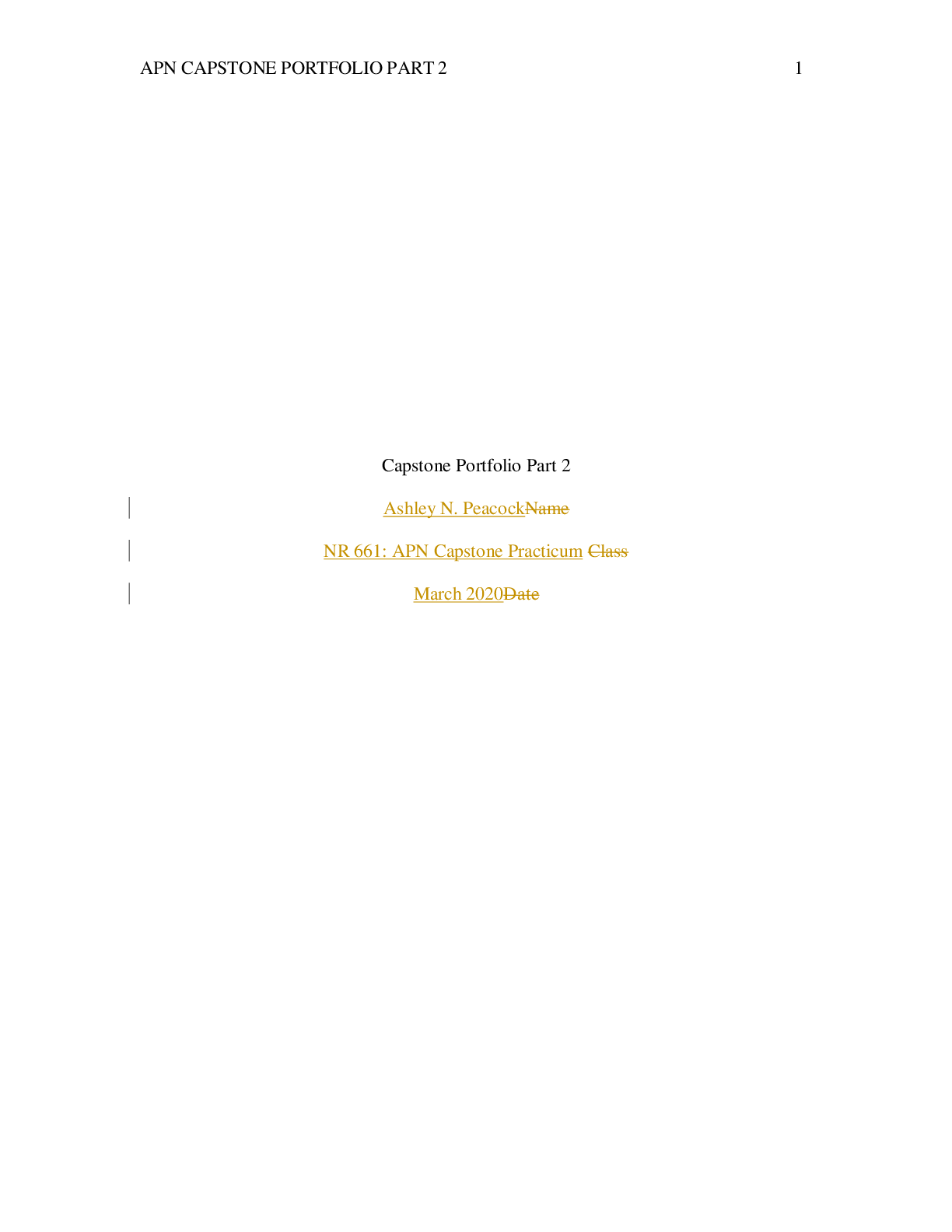
Reviews( 0 )
Document information
Connected school, study & course
About the document
Uploaded On
Sep 14, 2021
Number of pages
68
Written in
Additional information
This document has been written for:
Uploaded
Sep 14, 2021
Downloads
0
Views
74


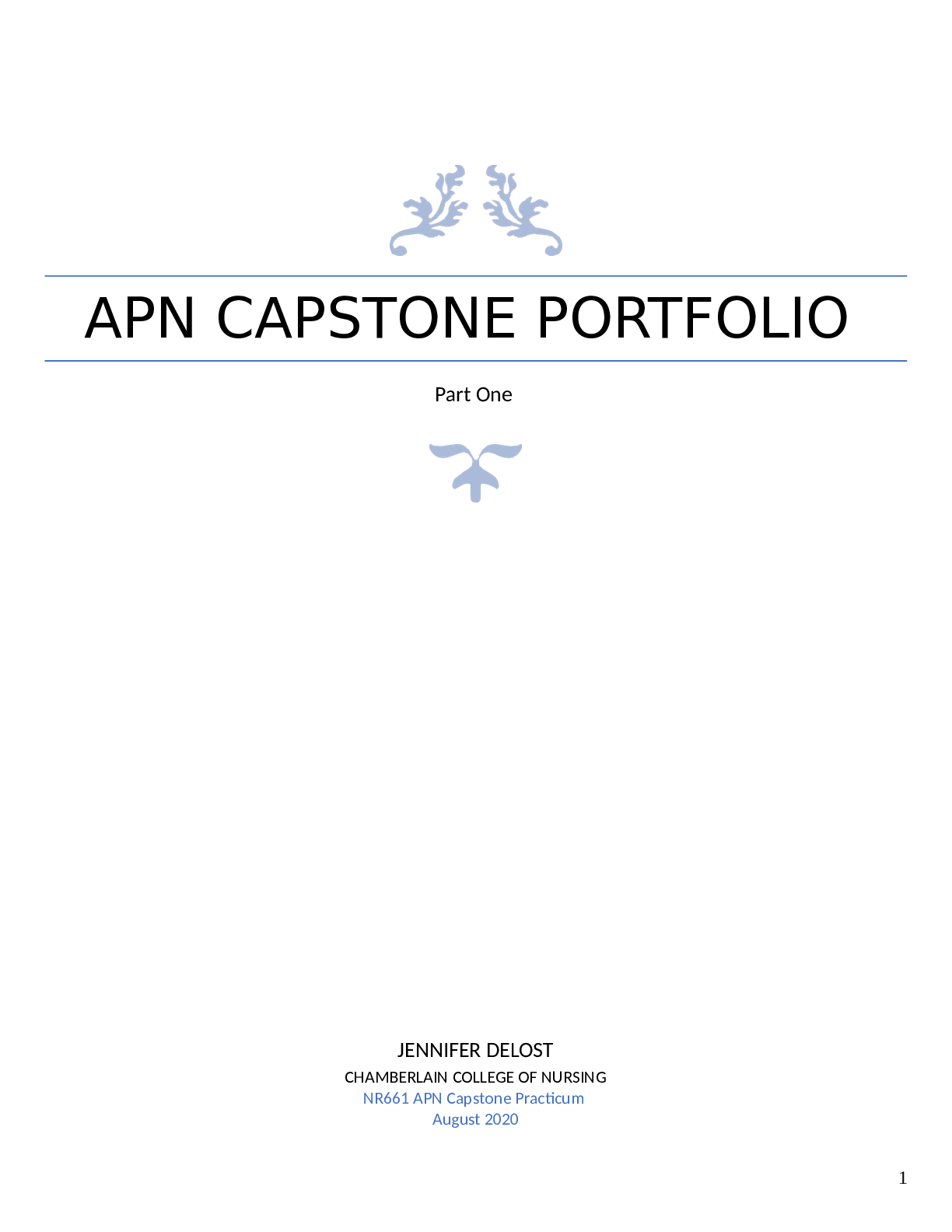



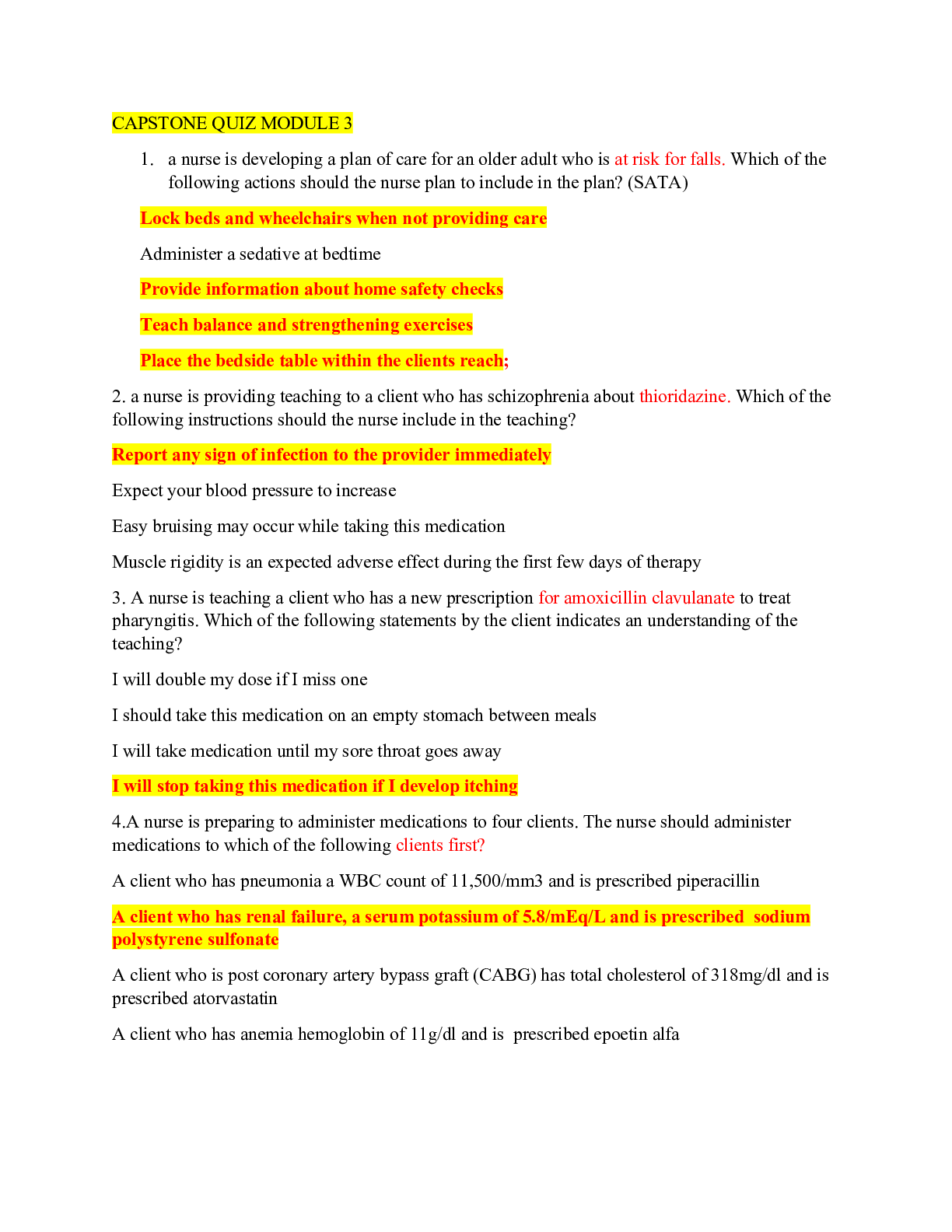

.png)

